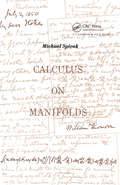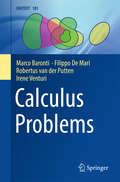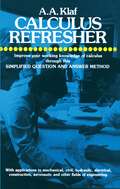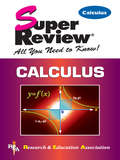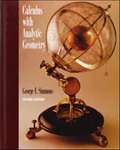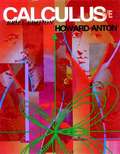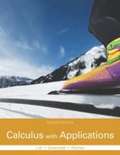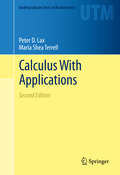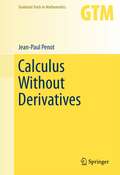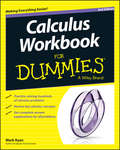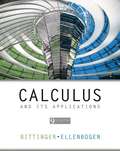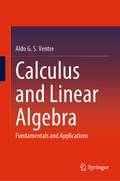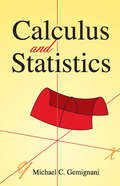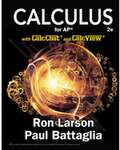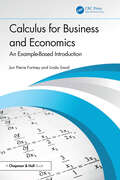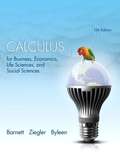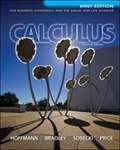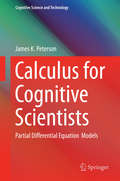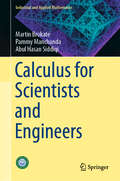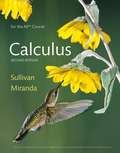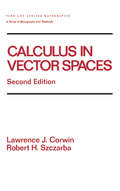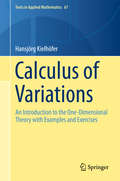- Table View
- List View
Calculus On Manifolds: A Modern Approach To Classical Theorems Of Advanced Calculus
by Michael SpivakThis little book is especially concerned with those portions of ?advanced calculus? in which the subtlety of the concepts and methods makes rigor difficult to attain at an elementary level. The approach taken here uses elementary versions of modern methods found in sophisticated mathematics. The formal prerequisites include only a term of linear algebra, a nodding acquaintance with the notation of set theory, and a respectable first-year calculus course (one which at least mentions the least upper bound (sup) and greatest lower bound (inf) of a set of real numbers). Beyond this a certain (perhaps latent) rapport with abstract mathematics will be found almost essential.
Calculus Problems (UNITEXT #101)
by Filippo Mari Marco Baronti Robertus Putten Irene VenturiThis book, intended as a practical working guide for students in Engineering, Mathematics, Physics, or any other field where rigorous calculus is needed, includes 450 exercises. Each chapter starts with a summary of the main definitions and results, which is followed by a selection of solved exercises accompanied by brief, illustrative comments. A selection of problems with indicated solutions rounds out each chapter. A final chapter explores problems that are not designed with a single issue in mind but instead call for the combination of a variety of techniques, rounding out the book's coverage. Though the book's primary focus is on functions of one real variable, basic ordinary differential equations (separation of variables, linear first order and constant coefficients ODEs) are also discussed. The material is taken from actual written tests that have been delivered at the Engineering School of the University of Genoa. Literally thousands of students have worked on these problems, ensuring their real-world applicability.
Calculus Refresher (Dover Books on Mathematics)
by A. A. KlafThis book is unique in English as a refresher for engineers, technicians, and students who either wish to brush up their calculus or find parts of calculus unclear. It is not an ordinary textbook. It is, instead, an examination of the most important aspects of integral and differential calculus in terms of the 756 questions most likely to occur to the technical reader. It provides a very easily followed presentation and may also be used as either an introductory or supplementary textbook. The first part of this book covers simple differential calculus, with constants, variables, functions, increments, derivatives, differentiation, logarithms, curvature of curves, and similar topics. The second part covers fundamental ideas of integration (inspection, substitution, transformation, reduction) areas and volumes, mean value, successive and partial integration, double and triple integration. In all cases the author stresses practical aspects rather than theoretical, and builds upon such situations as might occur. A 50-page section illustrates the application of calculus to specific problems of civil and nautical engineering, electricity, stress and strain, elasticity, industrial engineering, and similar fields. 756 questions answered. 566 problems to measure your knowledge and improvement; answers. 36 pages of useful constants, formulae for ready reference. Index.
Calculus Super Review (Super Reviews Study Guides)
by Editors of REAGet all you need to know with Super Reviews! Each Super Review is packed with in-depth, student-friendly topic reviews that fully explain everything about the subject. The Calculus I Super Review includes a review of functions, limits, basic derivatives, the definite integral, combinations, and permutations. Take the Super Review quizzes to see how much you've learned - and where you need more study. Makes an excellent study aid and textbook companion. Great for self-study! DETAILS - From cover to cover, each in-depth topic review is easy-to-follow and easy-to-grasp - Perfect when preparing for homework, quizzes, and exams! - Review questions after each topic that highlight and reinforce key areas and concepts - Student-friendly language for easy reading and comprehension - Includes quizzes that test your understanding of the subject
Calculus With Analytic Geometry (Second Edition)
by George F. SimmonsIt is a curious fact that people who write thousand-page textbooks still seem to find it necessary to write prefaces to explain their purposes. Enough is enough, one would think. However, every textbook--and this one is no exception--is both an expression of dissatisfaction with existing books and a statement by the author of what he thinks such a book ought to contain, and a preface offers one last chance to be heard and understood.
Calculus With Analytic Geometry, Brief Edition
by Howard AntonThe aim of this major revision is to create a contemporary text which incorporates the best features of calculus reform yet preserves the main structure of an established and well-tested calculus course. The multivariate calculus material is completely rewritten to include the concept of a vector field and focuses on major physics and engineering applications of vector analysis. Covers such new topics as Jacobians, Kepler's laws, conics in polar coordinates and parametric representation of surfaces. Contains expanded use of calculator computations and numerous exercises.
Calculus With Applications (Eleventh Edition)
by Margaret L. Lial Raymond N. Greenwell Nathan P. RitcheyCalculus with Applications is a thorough, applications-oriented text for students majoring in business, management, economics, or the life or social sciences.
Calculus With Applications (Undergraduate Texts in Mathematics)
by Peter D. Lax Maria Shea TerrellThis new edition of Lax, Burstein, and Lax's Calculus with Applications and Computing offers meaningful explanations of the important theorems of single variable calculus. Written with students in mathematics, the physical sciences, and engineering in mind, and revised with their help, it shows that the themes of calculation, approximation, and modeling are central to mathematics and the main ideas of single variable calculus. This edition brings the innovation of the first edition to a new generation of students. New sections in this book use simple, elementary examples to show that when applying calculus concepts to approximations of functions, uniform convergence is more natural and easier to use than point-wise convergence. As in the original, this edition includes material that is essential for students in science and engineering, including an elementary introduction to complex numbers and complex-valued functions, applications of calculus to modeling vibrations and population dynamics, and an introduction to probability and information theory.
Calculus Without Derivatives (Graduate Texts in Mathematics #266)
by Jean-Paul PenotCalculus Without Derivatives expounds the foundations and recent advances in nonsmooth analysis, a powerful compound of mathematical tools that obviates the usual smoothness assumptions. This textbook also provides significant tools and methods towards applications, in particular optimization problems. Whereas most books on this subject focus on a particular theory, this text takes a general approach including all main theories. In order to be self-contained, the book includes three chapters of preliminary material, each of which can be used as an independent course if needed. The first chapter deals with metric properties, variational principles, decrease principles, methods of error bounds, calmness and metric regularity. The second one presents the classical tools of differential calculus and includes a section about the calculus of variations. The third contains a clear exposition of convex analysis.
Calculus Workbook For Dummies
by Mark RyanYour light-hearted, practical approach to conquering calculus Does the thought of calculus give you a coronary? You aren't alone. Thankfully, this new edition of Calculus Workbook For Dummies makes it infinitely easier. Focusing "beyond the classroom," it contains calculus exercises you can work on that will help to increase your confidence and improve your skills. This hands-on, friendly guide gives you hundreds of practice problems on limits, vectors, continuity, differentiation, integration, curve-sketching, conic sections, natural logarithms, and infinite series. Calculus is a gateway and potential stumbling block for students interested in pursuing a career in math, science, engineering, finance, and technology. Calculus students, along with math students in nearly all disciplines, benefit greatly from opportunities to practice different types of problems--in the classroom and out. Calculus Workbook For Dummies takes you step-by-step through each concept, operation, and solution, explaining the "how" and "why" in plain English, rather than math-speak. Through relevant instruction and practical examples, you'll soon learn that real-life calculus isn't nearly the monster it's made out to be. Master differentiation and integration Use the calculus microscope: limits Analyze common functions Score your highest in calculus Complete with tips for problem-solving and traps to avoid, Calculus Workbook For Dummies is your sure-fire weapon for conquering calculus!
Calculus Workbook For Dummies (For Dummies Series)
by Mark RyanThe easy way to conquer calculus Calculus is hard—no doubt about it—and students often need help understanding or retaining the key concepts covered in class. Calculus Workbook For Dummies serves up the concept review and practice problems with an easy-to-follow, practical approach. Plus, you’ll get free access to a quiz for every chapter online. With a wide variety of problems on everything covered in calculus class, you’ll find multiple examples of limits, vectors, continuity, differentiation, integration, curve-sketching, conic sections, natural logarithms, and infinite series. Plus, you’ll get hundreds of practice opportunities with detailed solutions that will help you master the math that is critical for scoring your highest in calculus. Review key concepts Take hundreds of practice problems Get access to free chapter quizzes online Use as a classroom supplement or with a tutor Get ready to quickly and easily increase your confidence and improve your skills in calculus.
Calculus and Its Applications
by Marvin L. Bittinger David J. EllenbogenCalculus and Its Applications, Ninth Edition, is the most student-oriented applied calculus text on the market. The authors believe that appealing to students' intuition and speaking in a direct, down-to-earth manner make this text accessible to any student possessing the prerequisite math skills. However, it is not enough for a text to be accessible--it must also provide students with motivation to learn. Tapping into areas of student interest, the authors provide an abundant supply of examples and exercises rich in real-world data from business, economics, environmental studies, health care, and the life sciences. New examples cover applications ranging from charting CEO pay to the melting polar ice cap. Found in every chapter, realistic applications draw students into the discipline and help them to generalize the material and apply it to new and novel situations. To further spark student interest, hundreds of meticulously drawn graphs, illustrations, and tables appear throughout the text, making it a favorite among students who are visual learners. Appropriate for a one-term course, this text is an introduction to applied calculus. A course in intermediate algebra is a prerequisite, although the Appendix, "Review of Basic Algebra," together with Chapter R, provides a sufficient foundation to unify the diverse backgrounds of most students.
Calculus and Linear Algebra: Fundamentals and Applications
by Aldo G. VentreThis textbook offers a comprehensive coverage of the fundamentals of calculus, linear algebra and analytic geometry. Intended for bachelor’s students in science, engineering, architecture, economics, the presentation is self-contained, and supported by numerous graphs, to facilitate visualization and also to stimulate readers’ intuition. The proofs of the theorems are rigorous, yet presented in straightforward and comprehensive way. With a good balance between algebra, geometry and analysis, this book guides readers to apply the theory to solve differential equations. Many problems and solved exercises are included. Students are expected to gain a solid background and a versatile attitude towards calculus, algebra and geometry, which can be later used to acquire new skills in more advanced scientific disciplines, such as bioinformatics, process engineering, and finance. At the same time, instructors are provided with extensive information and inspiration for the preparation of their own courses.
Calculus and Statistics
by Michael C. GemignaniSelf-contained and suitable for undergraduate students, this text offers a working knowledge of calculus and statistics. It assumes only a familiarity with basic analytic geometry, presenting a coordinated study that develops the interrelationships between calculus, probability, and statistics.Starting with the basic concepts of function and probability, the text addresses some specific probabilities and proceeds to surveys of random variables and graphs, the derivative, applications of the derivative, sequences and series, and integration. Additional topics include the integral and continuous variates, some basic discrete distributions, as well as other important distributions, hypothesis testing, functions of several variables, and regression and correlation. The text concludes with an appendix, answers to selected exercises, a general index, and an index of symbols.
Calculus for AP®
by Ron Larson Paul BattagliaCalculus for AP® is designed specifically to support the course frameworks for AP® Calculus AB and AP® Calculus BC. Ron Larson has partnered with an AP® Calculus teacher to develop a series that meets the needs of the AP® Calculus course while helping students develop mathematical knowledge conceptually. With a clear focus on course demands, Calculus for AP® introduces content in the sequence most preferred by AP® Calculus teachers, resulting in more complete content coverage.
Calculus for Business and Economics: An Example-Based Introduction
by Jon Pierre Fortney Linda SmailCalculus for Business and Economics: An Example-Based Introduction is designed for first-year university students specializing in business and economics. This book is crafted in a clear, easy-to-read style, covering all the essential calculus-related topics that students are likely to encounter in their studies. With real-world business and economics applications seamlessly integrated around the core calculus concepts, students will find the book of real practical value throughout their time in university and beyond. Features Three hundred easy-to-follow examples throughout, carefully crafted to illustrate the concepts and ideas discussed. Numerous exercises to practice, with solutions available online to help you learn at your own pace. Each chapter concludes with a section showcasing the real-world business and economics applications of the discussed mathematical concepts.
Calculus for Business, Economics, Life Sciences, and Social Sciences
by Raymond Barnett Michael Ziegler Karl ByleenBarnett/Ziegler/Byleen is designed to help students help themselves succeed in the course. This text offers more built-in guidance than any other on the market–with special emphasis on prerequisites skills–and a host of student-friendly features to help students catch up or learn on their own.
Calculus for Business, Economics, Life Sciences, and Social Sciences, Brief Version
by Raymond Barnett Michael Ziegler Karl Byleen Christopher StockerHelps students “get the idea.” Calculus for Business, Economics, Life Sciences, and Social Sciences, Brief Version, 14th Edition offers more built-in guidance than any other text in its field ― with special emphasis on applications and prerequisite skills ― and a host of student-friendly features to help students catch up or learn on their own. The text’s emphasis on helping students “get the idea” is enhanced in the new edition by a design refresh, updated data and applications, and a robust MyLab™ Math course.
Calculus for Business, Economics, and the SocialaAnd Life Sciences
by Michael Price Laurence D. Hoffmann Gerald L. Bradley David SobeckiCalculus for Business, Economics, and the Social and Life Sciences, Brief Edition provides a sound, intuitive understanding of the basic concepts students need as they pursue careers in business, economics, and the life and social sciences. Students achieve success using this text as a result of the author's applied and real-world orientation to concepts, problem-solving approach, straight forward and concise writing style, and comprehensive exercise sets. More than 100,000 students worldwide have studied from this text!
Calculus for Cognitive Scientists: Partial Differential Equation Models (Cognitive Science and Technology #0)
by James K. PetersonThis book provides a self-study program on how mathematics, computer science and science can be usefully and seamlessly intertwined. Learning to use ideas from mathematics and computation is essential for understanding approaches to cognitive and biological science. As such the book covers calculus on one variable and two variables and works through a number of interesting first-order ODE models. It clearly uses MatLab in computational exercises where the models cannot be solved by hand, and also helps readers to understand that approximations cause errors - a fact that must always be kept in mind.
Calculus for Scientists and Engineers (Industrial and Applied Mathematics)
by Martin Brokate Abul Hasan Siddiqi Pammy ManchandaThis book presents the basic concepts of calculus and its relevance to real-world problems, covering the standard topics in their conventional order. By focusing on applications, it allows readers to view mathematics in a practical and relevant setting. Organized into 12 chapters, this book includes numerous interesting, relevant and up-to date applications that are drawn from the fields of business, economics, social and behavioural sciences, life sciences, physical sciences, and other fields of general interest. It also features MATLAB, which is used to solve a number of problems. The book is ideal as a first course in calculus for mathematics and engineering students. It is also useful for students of other sciences who are interested in learning calculus.
Calculus in Vector Spaces, Revised Expanded (Pure and Applied Mathematics #189)
by Lawrence CorwinCalculus in Vector Spaces addresses linear algebra from the basics to the spectral theorem and examines a range of topics in multivariable calculus. This second edition introduces, among other topics, the derivative as a linear transformation, presents linear algebra in a concrete context based on complementary ideas in calculus, and explains differential forms on Euclidean space, allowing for Green's theorem, Gauss's theorem, and Stokes's theorem to be understood in a natural setting. Mathematical analysts, algebraists, engineers, physicists, and students taking advanced calculus and linear algebra courses should find this book useful.
Calculus of Variations
by Hansjörg KielhöferThis clear and concise textbook provides a rigorous introduction to the calculus of variations, depending on functions of one variable and their first derivatives. It is based on a translation of a German edition of the book Variationsrechnung (Vieweg+Teubner Verlag, 2010), translated and updated by the author himself. Topics include: the Euler-Lagrange equation for one-dimensional variational problems, with and without constraints, as well as an introduction to the direct methods. The book targets students who have a solid background in calculus and linear algebra, not necessarily in functional analysis. Some advanced mathematical tools, possibly not familiar to the reader, are given along with proofs in the appendix. Numerous figures, advanced problems and proofs, examples, and exercises with solutions accompany the book, making it suitable for self-study. The book will be particularly useful for beginning graduate students from the physical, engineering, and mathematical sciences with a rigorous theoretical background.
